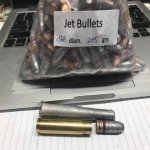The problem I have is that my barrel slugs at .326 (middle to the muzzle) but the throat would take no larger than .325. So the barrel is slightly larger closer to the end.
As far as the size of the bullet you seat, the measurement at the muzzle really isn't relevant.
The idea is to get the bullet from being seated in the case neck into the rifling with as little possibility for gases to to jet around the bullet before it is in the lands and grooves, obdurating the barrel. High pressure hot gases being able to get around your bullet is not your friend.
Were it my rifle, I'd load the diameter just below the point where they're too big for the loaded rounds to fully seat in the chamber. If I were feeling anal, I might even turn case necks down to take a bigger bullet (but I'm not that anal... so far). Then I'd head to the range and see how that worked before worrying about the increasing land/groove measurements towards the muzzle. It may be (although nobody can see it, it's theory and guess) that the dimensions in the ball seat/lead section of the chamber is where the pressures will bump up at least the bottom portion of your bullet to the ball seat/lead dimensions. And that just might be .325" or bigger. Things might possibly be just fine when the bullet gets to the .326" portions of your barrel. A thou difference at that point may not make a difference.
Did you slug and measure your ball seat/leade and measure it?
It's a level of work, but if you still have issues, you can pour a lead lap and lap the barrel until land and groove dimensions are consistent throughout the barrel. The bonus is that (depending on the depth of pitting, etc), you'll have cleaned up a lot of the rust and pitting you can see right now. Depending on depth of pitting, you could end up having what looks and acts pretty much like a new barrel.
Fire lapping (as already mentioned) could work although I'm kind of leery of it. Not because I think it's a bad idea, but simply because I've never tried it. I've always just made a lead lap and had at it. As the fire lapping does most of it's cutting near the the throat, diminishing the further it gets down the barrel (if my understanding is correct), maybe it's a method where the lapping eventually meets the larger dimensions starting at some point in the middle of the barrel. I don't know how much fire lapping it takes to increase dimensions a thou or thou and a half. Somebody here has probably done that.
You can buy pin gauges in half thou sizes fairly cheaply. Buy two or three of the right sizes, and you'll know when your bore dimensions are consistent from end to end. That's an assumption that when the bore/land size is uniform, then the groove sizes are uniform as well after lapping.
I've done something like this before.
Ultimately, my Grandpop's Model 1895, manufactured in 1898, passed from my Dad to me. It's chambered in 30 U.S. (now known as 30/40 Krag). While my grandfather was still alive, where he wanted to go hunting, the shots that he got an opportunity for were about 50 yards at most. Killed elk just fine. I now wonder if that was his preference because at his age, he couldn't see that razor blade thin front sight and pull it down into the miniscule little slot in the buckhorn rear. I couldn't see them, and so I had Bill Leeper fit a Lee Enfield #4 thick front sight, and I purchased a replica Lyman rear aperture no drill rear sight. Enormous difference.
Anyways, when the rifle originally passed down to me after Dad died, I immediately found that accuracy was abysmal. The bore was a bit dark, probably from hunting trips using the corrosive ammunition of the time. Some bore slugging showed that while it was a 30 caliber cartridge, the barrel's dimensions would have more properly been on a .303 British. A weekend of lead lapping, the bore was much cleaner, and with jacketed .311" bullets intended for use in .303 British instead of in .30/40 Krag, off the bench the accuracy with the aperture sights would be good enough to be minute of elk at 300 yards (a distance I wouldn't take that shot at with that rifle at an elk).
As it's one of the rifles I enjoy reserving for cast bullets, I ended up using a bullet mould intended for use casting for my Lee Enfield. Sized .313" as the max they'll chamber at when seated, they're still undersize for the barrel dimensions. After load development, it doesn't seem to make a difference. That could possibly be because there's a very long ball seat/lead in this rifle whether from the factory or a century plus of wear and tear. And perhaps the bullets are bumping up to obdurate in that section.
The cast bullet hunting load for this rifle makes it an honest 250 yard rifle. At 200 yards, the cast bullet loads group better than the jacketed loads; my guess would be because the cast bullet has superior fit versus the jacketed bullets.
And a final thought: you can always attempt paper patching for your rifle. I've never had reason or the inclination to try it, but a lot of guys who do that post that they're extremely happy with the results.









































































